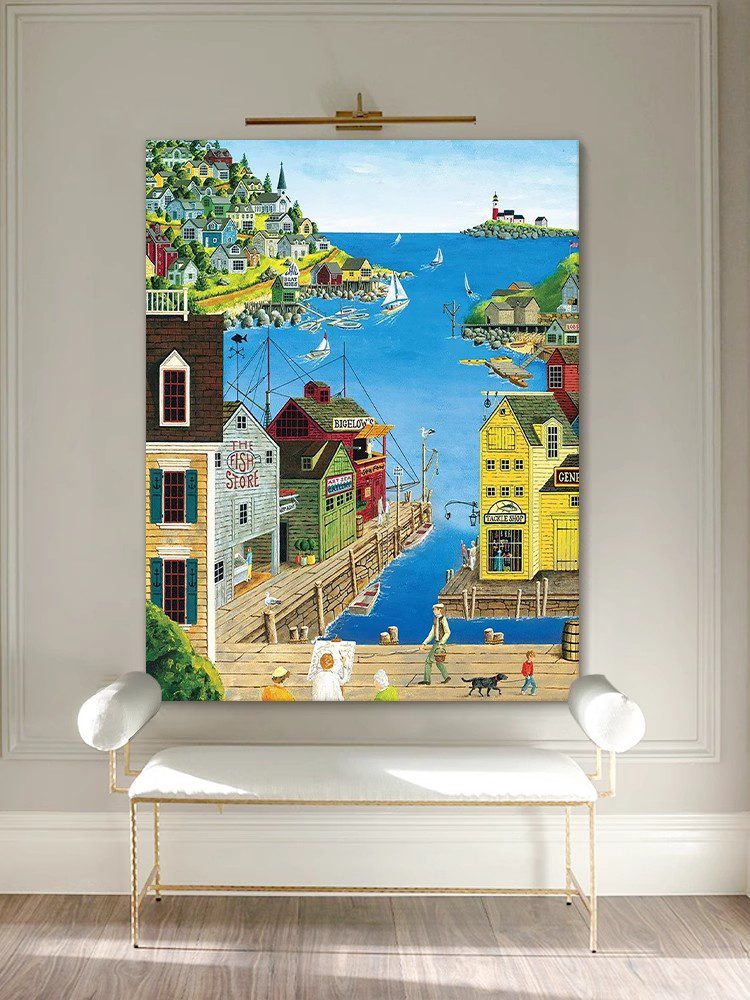The Impact of Composition on Appreciating Hand-Painted Oil Art: How Arrangement Shapes Emotion, Balance, and Narrative
Composition is the foundation of visual storytelling in hand-painted oil art, dictating how elements are organized to guide the viewer’s eye, evoke emotions, and convey meaning. Unlike photography or digital art, oil paintings rely on deliberate placement of lines, shapes, and spaces, often leaving visible traces of the artist’s planning or spontaneity. A well-composed piece feels harmonious and intentional, while a poorly structured one may feel chaotic or disjointed. Below, explore how composition influences the appreciation of oil art through its ability to create balance, direct focus, and enhance thematic depth.
1. Establishing Visual Balance: Symmetry vs. Asymmetry in Emotional Tone
Balance in composition refers to the distribution of visual weight across the canvas, creating stability or tension. Symmetrical compositions, where elements are mirrored along a central axis, evoke calmness, order, and formality. Historical portraits or religious paintings often use symmetry to convey authority or divinity, such as a figure seated centrally with equal space on either side. Asymmetrical compositions, by contrast, place elements unevenly, generating dynamism and intrigue. For example, a still life might position a vase of flowers off-center, balanced by a draped cloth or shadow on the opposite side. This interplay of imbalance and equilibrium reflects real-world complexity, inviting viewers to explore the canvas actively. Observe how the artist distributes light, dark, and detailed areas: Does the painting feel grounded or unsettled? How does this choice align with the subject’s emotional or narrative context?
2. Guiding the Viewer’s Eye: Focal Points and Visual Pathways
Composition acts as a map for the viewer’s gaze, using lines, contrast, and placement to emphasize key elements. Artists often create focal points through techniques like color intensity, detail, or isolation. A bright red apple in a muted still life instantly draws attention, while a figure’s face in a portrait becomes the anchor through fine brushwork and lighting. Beyond focal points, composition establishes pathways using implied lines—such as the direction of a gaze, the curve of a branch, or the angle of a building—that lead the eye through the scene. For instance, a landscape might use a winding river or row of trees to guide viewers from the foreground to a distant mountain. Analyze the painting’s flow: Does your eye move smoothly between elements, or does it get stuck in certain areas? How do pathways reinforce the narrative or emotional arc of the piece?
3. Creating Depth and Space: Foreground, Middle Ground, Background Relationships
Oil paintings rely on compositional techniques to simulate three-dimensional space on a flat surface, a skill that enhances realism or stylistic expression. Artists use overlapping shapes, size variation, and atmospheric perspective (where distant elements are painted with softer edges and cooler tones) to create depth. In a portrait, a figure in the foreground might overlap a chair or curtain, while a landscape could layer trees, hills, and clouds to recede into the distance. Some styles, like Cubism, deliberately flatten space to challenge perception, using fragmented shapes that intersect at odd angles. Examine how the artist structures space: Are elements stacked in a way that feels natural or abstract? How does the treatment of depth influence the painting’s mood—does it feel intimate and immediate, or vast and contemplative?
4. Enhancing Narrative Clarity: Symbolism and Thematic Unity Through Arrangement
Composition is a storytelling tool, organizing elements to reinforce themes or symbolism. In historical or allegorical paintings, every figure or object is placed with purpose. For example, a Renaissance scene might position a biblical figure at the center, surrounded by smaller, secondary characters whose gestures or positions hint at their relationships or roles in the story. Even abstract works use composition to convey ideas; a chaotic arrangement of colors and shapes might symbolize inner turmoil, while a grid-like structure could evoke order or confinement. Consider the painting’s title or subject: How does the arrangement of elements clarify or complicate its meaning? Are there hidden connections between seemingly unrelated parts, such as a recurring shape or color that ties the composition together?
5. Evoking Movement and Rhythm: Dynamic Arrangements vs. Static Harmony
Composition can inject energy or tranquility into a painting through the placement of lines and shapes. Diagonal lines, for instance, create a sense of motion or instability—a tilted horizon in a seascape might suggest a storm, while a figure leaning forward implies action. Curved lines, by contrast, soften a scene, as seen in the gentle arc of a flower’s stem or the flowing fabric of a dress. Repetition of shapes or colors can establish rhythm, like the staggered roofs of a village or the alternating light and dark strokes in a foliage study. Notice how the artist uses these elements: Does the composition feel static and meditative, or alive with implied movement? How does this choice align with the painting’s broader emotional or thematic goals?
Composition is the silent architect of hand-painted oil art, transforming scattered elements into a cohesive whole. By analyzing balance, focal points, depth, narrative structure, and rhythm, viewers gain insight into the artist’s intentions and the painting’s deeper layers of meaning. Whether a work is chaotic or orderly, abstract or realistic, its composition reveals the invisible framework that makes it resonate emotionally and intellectually.
